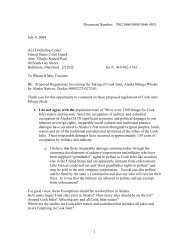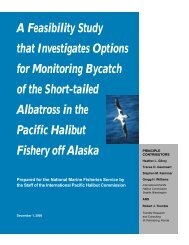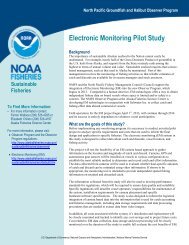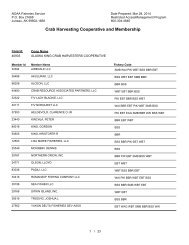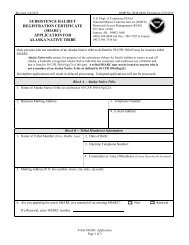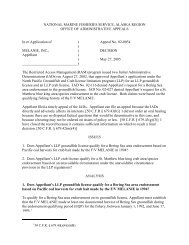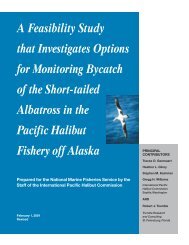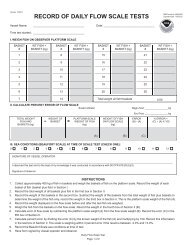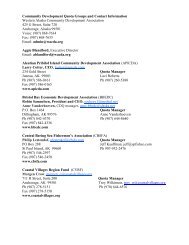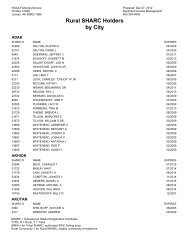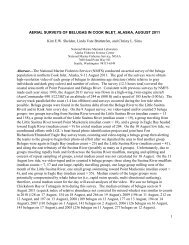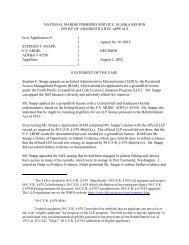Petition to List Lynn Canal Pacific Herring under the Endangered ...
Petition to List Lynn Canal Pacific Herring under the Endangered ...
Petition to List Lynn Canal Pacific Herring under the Endangered ...
You also want an ePaper? Increase the reach of your titles
YUMPU automatically turns print PDFs into web optimized ePapers that Google loves.
present and threatened destruction, modification and curtailment of spawning areas will<br />
fur<strong>the</strong>r restrict <strong>the</strong> habitat and range for <strong>Lynn</strong> <strong>Canal</strong> <strong>Herring</strong>.<br />
A species profile of <strong>Pacific</strong> <strong>Herring</strong> prepared by <strong>the</strong> U.S. Fish and Wildlife<br />
Service and <strong>the</strong> U.S. Army Corps of Engineers, Lassuy (1989), concluded that herring do<br />
not re-colonize spawning beds once <strong>the</strong>y are lost.<br />
One ra<strong>the</strong>r surprising generalization made by Cushing (1985) was that<br />
‘management of herring s<strong>to</strong>cks based on a great expenditure of research has not<br />
been very successful.’ In view of such management difficulties, <strong>the</strong> very basic<br />
concerns of o<strong>the</strong>rs take on a special importance – especially with respect <strong>to</strong><br />
coastal development policy. I refer <strong>to</strong> <strong>the</strong> statement by Trumble (1983) that ‘<strong>the</strong>re<br />
is no clear instance of a s<strong>to</strong>ck successfully moving its spawning area as a result of<br />
destruction or major alteration of <strong>the</strong>ir original spawning area.’ A study of<br />
transplantation of eggs concluded that though eggs hatched, a new spawning<br />
population did not become established (Hay and Marliave 1988). Clearly, <strong>the</strong><br />
maintenance of vegetation is a valid concern.<br />
Also pertinent <strong>to</strong> <strong>the</strong> maintenance of functional spawning grounds is <strong>the</strong><br />
avoidance of activities (e.g. dredging) which would cause silting immediately<br />
before, during, and two <strong>to</strong> three months following <strong>the</strong> spawning season. The<br />
inhibition of spawning behavior, suffocation of eggs, and destruction of product<br />
quality were mentioned earlier. It also seems likely <strong>to</strong> me that a heavy loading of<br />
suspended sediment would be ingested of feeding inhibited during a period<br />
critical <strong>to</strong> <strong>the</strong> nutrition of both adult and newly hatched larvae. Boehlert and<br />
Morgan (1985) noted that sediment at ‘low suspension levels’ roughly equivalent<br />
<strong>to</strong> natural conditions actually enhanced larval feeding abilities. Higher loads, as<br />
might be expected in catastrophic events, inhibited feeding.<br />
(Lassuy 1989). This sobering assessment implicate <strong>the</strong> destruction of spawning grounds<br />
as a major fac<strong>to</strong>r in herring declines.<br />
In <strong>the</strong> case of <strong>Lynn</strong> <strong>Canal</strong> <strong>Herring</strong>, several researchers have noted that <strong>the</strong><br />
destruction of spawning beds in Auke Bay is a major fac<strong>to</strong>r in <strong>the</strong> population’s decline.<br />
Ano<strong>the</strong>r fac<strong>to</strong>r widely cited by regional experts has been <strong>the</strong> progressive<br />
deterioration of shoreline habitats that were his<strong>to</strong>rically used by <strong>Lynn</strong> <strong>Canal</strong><br />
herring as spawning areas. Auke Bay, which was once a major spawning area for<br />
<strong>the</strong> <strong>Lynn</strong> <strong>Canal</strong> s<strong>to</strong>ck, has been increasingly subjected <strong>to</strong> <strong>the</strong> cumulative effects of<br />
shoreline development and human use since <strong>the</strong> 1980s. These impacts include<br />
construction of a floating breakwater, docks and marinas for commercial and<br />
recreational vessels, fueling depots, sewage and waste treatment discharges, and<br />
ferry terminal expansion. In addition, current proposals include <strong>the</strong> development<br />
of a seafood processing plant. The his<strong>to</strong>ric extent of eelgrass (Zostera marina)<br />
beds once used by herring as spawning habitat have also declined in <strong>the</strong> bay over<br />
time (personal communication, Sue Walker, NMFS). Though direct evidence for<br />
41



